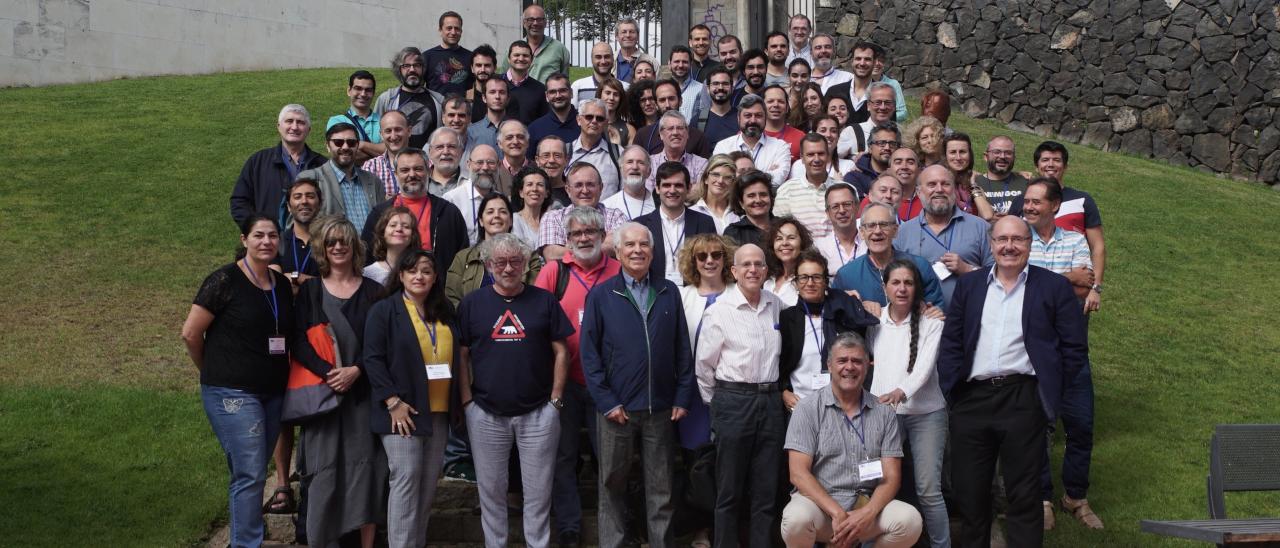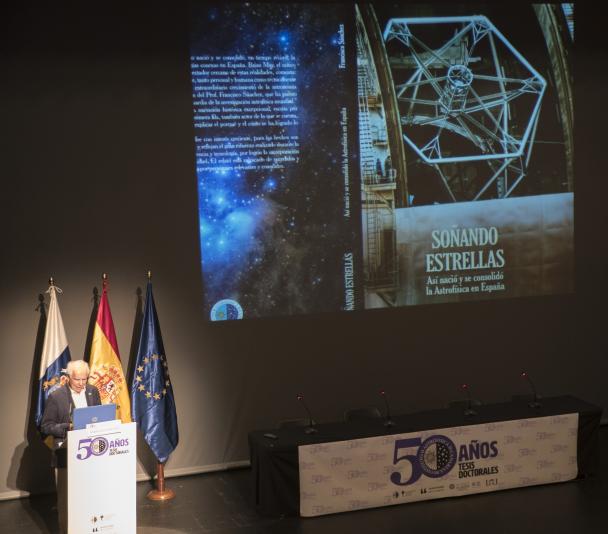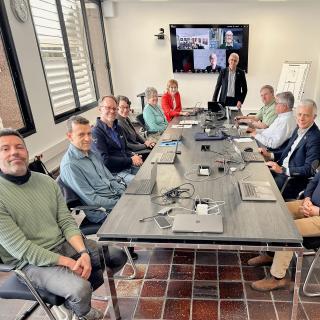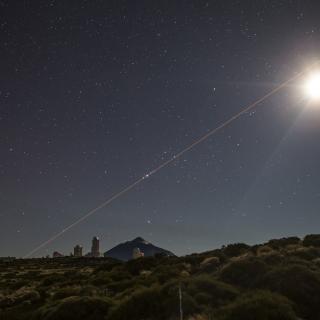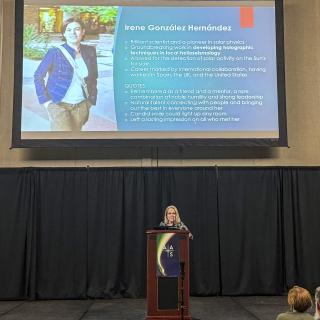The 50 years of doctoral theses in the Instituto de Astrofísica de Canarias (IAC) were summarized in the 20 talks which made up the two day conference which was celebrated in Tenerife, organized by the IAC in collaboration with the University of La Laguna.
All the talks were linked to the Instituto de Astrofísica de Canarias (IAC) and its observatories. The great majority of the speakers defended their theses in the University of La Laguna. Today many of these former doctoral students are IAC researchers, while others belong to centres of astrophysical research and to universities in Spain and abroad. Some have become directors of institutes or observatories around the world, including one researcher working on the development of astronomy in Africa. This is the broad spectrum of a group which met for two days in La Laguna, (Tenerife) to celebrate an anniversary: 50 years of doctoral theses at the IAC, which coincided with other anniversaries: ten years since the Gran Telescopio Canarias (GTC) went into operation, 100 years since the eclipse which gave proof of the General Theory of Relativity, 100 years since the creation of the International Astronomical Union (IAU) and 150 years since the discovery of the Periodic Table of the elements.
After the inauguration on Wednesday evening by the first Professor of Astrophysics in the Canaries, Francisco Sánchez, the conference proper began on Thursday morning with the talk by José Manuel Vilchez, researcher at the Instituto de Astrofisica de Andalucía who, as he himself said, “belonged to the first crop of Resident Astrophysicists of the IAC”. At that time the astrophysics carried out was basically infrared photometry with a telescope at the Teide Observatory ceded by the British. Some years later, in his doctoral thesis supervised by Bernard Pagel, he formulated the first model of the chemical evolution of the galaxy M33, based on data from the Isaac Newton Telescope at the Roque de los Muchachos Observatory (La Palma). Vilchez is a past Director of the IAA, and his current research is on galaxies with extreme properties, which hark back to the early epoch of evolution of the universe.
Teo Muñoz Darias, an astrophysicst at the IAC, gave a talk about the past, present, and future of research on binary star systems containing black holes, which exhibit extreme phenomena. He reminded us of the article which appeared on February 13th 1992 about V404 Cygni, the first stellar mass black hole confirmed by dynamics, and a result in the doctoral thesis of Jorge Casares. Today work is continuing on candidates detected with X-ray satellites, to measure their fundamental parameters, and the processes of accretion onto black holes. These are often transitory, showing a quiet phase which can last years, and an eruption lasting months, such as that shown in 2015 by V404 Cygni, which “awoke” with unusual violence after over 25 years of inactivity. Teo Muñoz studies the winds which occur during these eruptions, and which seem to occur in all stellar mass black holes.
Eduardo Martín Guerrero de Escalante, now a researcher at the Centre for Astrobiology, of the CSIC-INTA, talked about the variety of habitable worlds, and the probability that they are in fact inhabited. He startd by reminding us about the anniversary of the Periodic Table of the elements. “We take it for granted” he warned, “that the chemical elements are extraterrestrial in origin, but we do not think the same of life, even though it could have originated outside our planet”. He reminded us of the 25 doctoral theses about substellar objects (brown dwarfs and planets). He himself, together with two other IAC researchers, María Rosa Zapatero Osorio and Rafael Rebolo López, in 1995 discovered the first brown dwarfs, substellar objects of which here are tens of thousands of millions in our galay. He also told us how in 1990 people began to show interest in astrobiology, which at that time had a much narrower scientific basis. Now this speciality has greater prestige, and he stated that he though that the origin of life is probably deterministic, because “it cannot be the result of pure chance”.
Ramón García López, a researcher at the IAC and the ULL told u show, starting from his interest in the chemical evolution of our galaxy and from stuyding the abundances of the light elements (lithium, berilium and boron) he had ended up by spending his recent years studying the more explosive events in the univers, in the field of astroparticles, a change brought ahout, in part, by the visit of the Nobel Laureate in Physics Samuel Ting to the Teide Observatory. Now working in the AMS (Alpha Magnetic Spectrograph) projecto on the International Space Station and with the MAGIC telescopes he knows that the future in this field is with the CTA (Cherenkov Telescope Array) and that it will produce new theses and projects.
The ancient Egyptians wrote that they oriented their temples following astronomical patterns. Juan Antonio Belmonte, an IAC researcher, has confirmed this, and he told us about it in his talk “In unknown territor: cosmologies of the past through archaeoastronomy”. His interest for this speciality,(although he started in stellar physics) goes back to the work by him and his colleagues at the IAC about the Pyramids of Güímar (Tenerife). Now he is studying archaeoastronomical clues in several of the Canary Islands, and in the Peninsula, as well as in Egypt and at Petra in Jordan, which is currently his main interest. He emphasized the thesis of Andrea Rodríguez, the first in a Department of Astrophysics in Spain, and that the Risco Caido and the Sacred Mountains of Grand Canary have been declared a World Heritage Site, a proof that “astronomy is not only an ideal tool to orient oneself in time and space, but it searches for answers to the basic questions and has a major capacity to generate metaphysics and to fight against the powerful”. It also “stengthens the heritage of a country”
Pere Lluis Pallé, a solar physicst at the IAC started his talk by reminding us of a question posed in 1926 by the physicist Sir Arthur Eddington “What type of apparatus can perforate the upper layers of a star to probe its internal conditions?”, or in another way “How can we get to know the interiors of the stars” the answer is in helioseismology and in asteroseismology, which in the IAC have produced 25 “vibrant” theses. “We were pionieers in this story” said Pallé proudly.This is true, helioseismology was born with the aid of the Mark-1 spectrophotometer, invented in Birmingham, UK, with which Teoedoro Roca Cortés produce his doctoral thesis, and which marked the beginning of these lines of research in the IAC. Today measuring and characterising the modes of oscillation of the Sun has been extended very successfully to other star. And these studies with observational instruments on the ground (the GONG and SONG networks) and from the SOHO satellite have been augmented in the past ten years with the space missions COROT, Kepler, and TESS.
Minia Manteiga, full Professor at the University of A Coruña, was a member of the fourth generation of Resident Astrophysicists at the IAC, and started by studying the blue straggler stars as an example of stellar evolution. However, as she emphsized in her talk, the way astronomy is performed has changed a great deal over time, because we have entered the era of Big Data, and Artificial Intelligence. Maybe for that reason she now works with large data bases, principally with that from the Gaia mission of the European Space Agency (ESA), whose objective is to build a three dimensional map of the stars in our Galaxy.
Teodoro Roca, full Professor of Astrophysics at the ULL and and IAC researcher presented a talk in a humorous style with the title “And now there are 333…” in reference to the number of doctoral theses commemorated in this conference, although he announced that in the next few weeks another seven would be defended. He took a few moments to pay tribute to the doctores in astrophysics who, unfortunately, are no longer with us. He also mentioned John Beckman, Doctor Honoris Causa of the ULL, and Mercedes Prieto Muñoz, the first woman to obtain a doctorate in astrophyics at this university. Today the average proportion of women obtaining their doctorates is between 30% and 40% of the total. Roca Cortés gave a summary of the Doctoral Study Plans (1870, 1985, 1998, and 2012) and the different stages of the history of the doctora theses at the IAC, making an analogy with the classical chronology of human history: Prehistory (1969-1983), Ancient History (1983-1998), Modern History (1998-2011) and Contemporary History (2011-present day). His talk was lavishly illustrated with attractive potos, above old potos, of people linked to the iAC.
Luis Fernando Rodríguez, an IAC engineer and a doctor in astrophysics, gave a description of the doctoral theses whose research has been performed in the instrument división, defending the idea that this type of academic work has great value because it can give rise to the design and construction of novel instruments which benefit astrophysics. At the present time he is the director of a long term programme of training doctors in the technology associated with this science. “ Our aim” he said “ is to produce one thesis per year in instrumentation (the current average is 0.675)” even though we know the problems give by this aim, such as the time required to supervise this type of research.
Mirjana Povic, a researcher at the Ethiopian Space Science and Technology Institute (ESSTI), a doctor linked to the Instituto de Astrofísica de Andalucía (IAA) who defended her doctoral thesis at the IAC, impressed the audience when she presented the enormous effort being made in astronomy and space sciences in Africa. She talked particularly about Ethipioa and the projects in which she has been working since 2015. Ethiopia has recently given priority to these types of activity because of the benefits which they imply for the population. As for the question which many people pose about why should money be invested in science when Africa has necessities as basic as the water supply, Miriana’s answer is cler: science in general, and astronomy and space science in particular promote peace, and only with education in science and technology can the fate of the african continent be changed, and the struggle against poverty be won in the long term, thereby contributing to a more balanced world. For that reason it is necessary to inspire and motivate the children, and above all the girls, to take up science based disciplines. And we should not forget that Africa is a continent with one of the most valued resources in astrophysics: its dark skies.
The Friday sessions began with the IAC astrophysicist Cristina Ramos Almeida, who researches the nuclear activity in galaxies, and the phenomena of extinction, triggering and feedback in them. She stressed the importance of the active galactic nuclei (AGN), fueled by the effect of their central supermassive black holes. She pointed out that this field had been revalued recently producing new doctoral theses in the IAC and that the large telescopes such ast the GTC have played, and continue to play, a key role. At the moment Cristina is studying the effects of the AGN on their host galaxies, an influence which is greater than previously thought.
Antonio Eff Darwich is an excellent example of how outreach and education offer interesting professional opportunities for an astrophysicist. Although he started as an astrophysicist, in the field of helioseismolog, and then moved into geology, he is now working in the Department of Specific Didactics in the Faculty of Education of the ULL, after a number of academic positions. He presented statistics showing that after 50 years of doctoral theses in the ISA 84% of these doctors are still dedicated to research and/or teaching in the university (in the US and the UK the equivalent figure is only 7%) that 5% are working in secondary education, that 3% are in the rest of the public sector (air traffic control, telemedicine) 6& are in the private sector and 2% in outreach.
The IAC researcher Ignacio Trujillo explained that during the discussion of how the stellar populations in galaxies could be explained by cosmological simulations, and in particular how this bears on the most massive galaxies in the universe, the idea was proposed that in a hierarchical universe some galaxies should have remained unevolved. This caused astronomers to learch for these galaxies. In consequence in 2012 there was an article in Nature magazine about NGC 1277, a “relic” galaxy in the Perseus cluster, with an exceptionally supermassive central black hole. The absence of blue globular cluster which his team has shown (Nature, 2018) is the proof that this is a relic galaxy “a time capsule in our possession”.
Aníbal García, a researcher at the IAC gave us a tour of some of the scientific highlights from the IAC related to the formation of the chemical elements and the formation of complex molecular nanostructures in old stars. These studies have important implications in various areas of astrophysics, such as the chemical evolution of our Galaxy, and the anomalies in globular clusters. He picked out the role of the fullerenes, and of Graphene, complex carbon molecules which are basic to the understanding of the interstellar medium, and with potential applications in nanotechnology.
Valentín Martínez Pillet, the Director of the National Solar Observatory (NS0) of the United States, told us about the history of the group of solar spectropolarimetry at the IAC, and in particular about thos projects in which he was most involved.Among them was the Solar Orbiter mission, which he led until 2013, and which will be launched in 2020, the Sunrise mission, whose first stratospheric balloon was launched in 200i9 and which produced data about the magnetic field and the polarization at the solar surface which have still not been bettered, and the design of the TIP and the LPSP polarimeters for the solar telescopes of the Teide Observatgory. After being chosen as Director of the NSO he leads the science team of the large Daniel K Inouye Solar Telescope (DKIST) with its 4m diameter.
In the past 50 years there have been important advances in solar physics, both in observation and the development of instrumentation as well as in theoretical work to help measure magnetic fields, and in algorithms to help intepret all kinds of data. This was explained to us by the IAC researcher Andrés Asensio Ramos “a second generation solar physicist at the IAC” as he defined himself, comparing the evolution of the group with that of cars. In his talk he talked about the new techniques for measuring the magnetic field of the sun, and of the polarimetric work which he is doing: the production of codes to help analyze the copious volumen of information which will be produced by e.g. the new larges solar telescopes DKIST and EST (European Solar Telescope) and which are also applicable to other fields of astrophysics.
José Alberto Rubiño a researcher in cosmology at the IAC referred in his talk to the establishment of the standard cosmological model, which owes much to the discovery of the cosmic microwave background radiation (CMB) in 1965. In these studies the Teide Observatory has played a relevant role, with experiments such as COSMOSOMAS, developed entirely within the IAC, and the Tenerife Experioment, which was the first ground based experiment to confirm the anisotropies discovered by COBE in 1992. Rubiño noted the Planck mission where the IAC contributed the control electronics and led one of the 7 science groups, and the QUIJOTE Experiment (QUI Joint Tenerife experiment) led by Rafael Rebolo, and with which it may be possible to detect the gravitational waves emitted during the Big Bang. The Japanese satellite LiteBIRD, the next space mission to observe the background radiation, is awaited with high hopes. Maybe this will tell us clearly how the universe started and if there really was an inflationary phase. Rubiñlo made special mention of astronomers including Eduardo Battaner, Rod Davies, Robert Watson, Fernando Atrio, and Rashid Sunyaev.
Julia de León Cruz, an IAC researcher, is an expert in the physical properties and the composition of the so-called “Small Solar System Bodies”, among them the asteroids, the transneptunian objects, the Centaurs, and the comets, although she started work making an index of space debris. In her talk she mentioned the scientists of the IAC who, to a greater or lesser degree, did work in this field before the first dedicated theses, of which the first was that by Javier Licandro. Julia’s thesis was about the mineralogical characteristics of near Earth asteroids. She mentioned some of the highlights in this field made by telescopes on the ground, such as the GTC, as well as the participation of the IAC group in two NASA space probes to comets.She also mentioned Pluto, now formally catalogued as a dwarf planet.
Arturo Manchado, a researcher at the iAC and with the Higher Council for Scientific Research (CSIC) is a specialist in the late stages of stellar evolution. He started by recalling how he used data from a spectrograph with a photon counting detector (IPCS) in his doctoral thesis about planetary nebulae directed by the American-Dutch astrophysicist Stuart Pottasch. After his thesis there followed a line of researchers whose contributions about bipolar and cuadrupolar planetary nebulae made up the remainder of his talk.
The last presentation was by Rosa González Delgado, a researcher at the Instituto de Astrofísica de Andalucía (IAA) who talked about “Galaxies, structure and evolution of their stellar populations”. She commented on various aspects of her thesis about the relation between star formation and nuclear activity in galaxies. She is currently working in the CALIFA project (Calar Alto Legacy Integral Feidl Area survey) which has obtained the biggest sample until now of data about the spatially resolved properties of galaxies; the project is aimed at researching star formation in nearby galaxies to help understand its role in the history of the universe.
Ignacio González, Head of the Department of Astrophysics at the ULL and Coordinator of Higher Education at the IAC, who organized the conference, closed the final act by inviting the veteran astrophysicist at the IAC John Beckman, and the Director Rafael Rebolo, his first graduate student at the IAC, to say a few words. They both expressed their great satisfaction with this highly agreeable meeting.
Other press releases:
50 years “Dreaming about the stars”
Conference: Impulsando la Astrofísica en España: 50 años de tesis doctorales en el IAC
